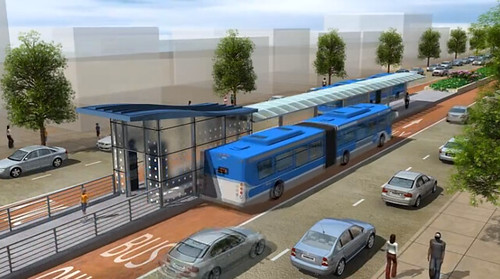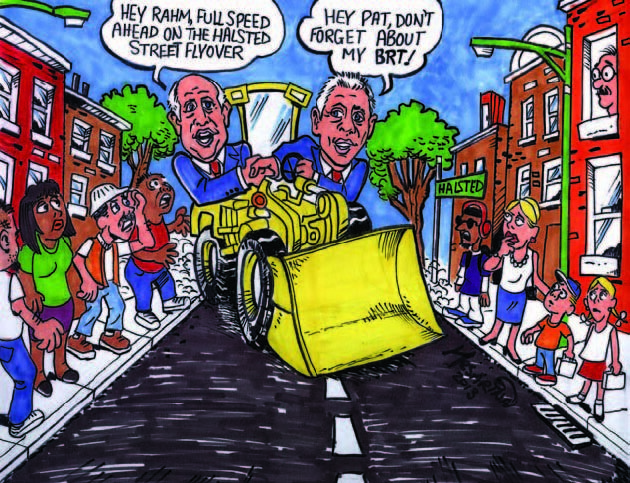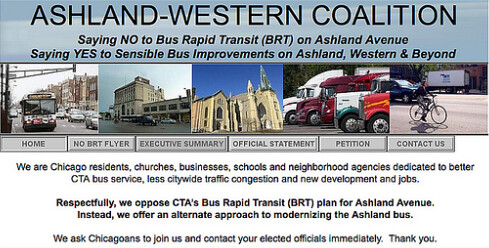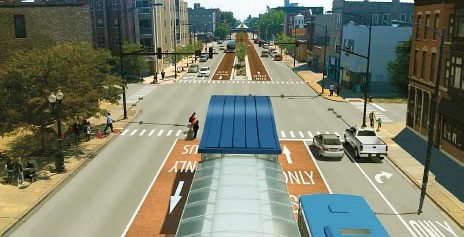While the CTA goes forward with the environmental analysis and conceptual engineering phase of designing the first 5.4-mile stretch of bus rapid transit on Ashland Avenue, the NIMBY crowd is also on the move.
On August 1, the Gazette community newspaper ran their second tone-deaf anti-BRT editorial in two months. This time, they lumped the Ashland plan in with the Circle Interchange Expansion as examples of government run amok, destroying quality of life. The paper nailed the Circle Interchange issue, describing how this $475 million project, rammed through the planning process, will degrade the pedestrian environment and lower property values. But what that has to do with a transit project that will convert tens of thousands of car trips to bus trips, move people faster through the city, widen sidewalks, add green space and raise property values is anybody’s guess.
The editorial complained that, while the CTA held a series of community meetings on BRT last fall, the agency had not held any public forums on the project since it announced its choice of Ashland in April. However, CTA Spokeswoman Lambrini Lukidis says the agency held six design meetings with local groups, where details like loading zone placement were worked out, as part of the block-by-block analysis in June and July. Public meetings are scheduled for late summer and early fall. One was held Monday in the East Village neighborhood.
The design meetings included 18 different chambers of commerce, community groups, and businesses. Some of these merchant associations and businesses are members of the NIMBY group the Ashland-Western Coalition, which has floated a watered-down alternative proposal they’ve given the Orwellian name "Modern Express Bus" service. This would essentially just bring back the old, slow #X9 Ashland Express bus, plus a few BRT features and various bells and whistles. But make no mistake, the primary aim of the Ashland NIMBYs is to prevent the implementation of effective, center-running, dedicated bus lanes -- the single most important feature to get bus service unstuck from traffic.
If there were no BRT project moving forward right now, the ideas coming from the Ashland-Western Coalition would have some merit. But the fact is that Chicago is serious about launching world-class bus service on Ashland, and the Ashland-Western Coalition has put out their MEB proposal as a ploy to stop that from happening. Killing center-running bus lanes on Ashland won't give Chicagoans modern bus service. It will keep city streets stuck in the 20th century.
Like the proposed BRT service, the X9 stopped every half-mile, so it made roughly 75 percent fewer stops than the local buses, which generally stop every eighth-mile. While the center-running BRT buses, with their dedicated lanes, will travel 15.9 mph during peak hours, the X9 was blocked by the glut of private cars on Ashland, so it traveled 10.3 mph at peak hours, only slightly faster than the 8.7 mph locals. Meanwhile, MEB would only make 30 percent fewer stops, so it might actually be slower than the X9.
Recently, someone sent me a notice from the newsletter for the West Town Chamber of Commerce, one of the organizations in the anti-BRT group, for a meeting of the coalition. It was scheduled for Friday, August 2, at the First Baptist Congregational Church, 1613 West Washington. The notice included a link to the coalition’s website, AshlandWesternCoalition.com, which intrigued me, since the group has been active since at least last January, but I’d never been able to find a website via Google searches. It turns out the site only went live last month.
The website, which can also be accessed via the alarmist URL SaveAshland.com, includes an electronic petition asking Mayor Emanuel and the CTA not to install BRT on Ashland. Instead, it reads, “Chicago deserves common-sense solutions to modernize the Ashland bus.” A “No BRT Flyer” on the site warns that the BRT buses will only stop every half-mile, failing to mention that local service will be retained as well.
The website also includes a four-page “Executive Summary” and an eight-page “Official Statement.” But nowhere does it mention of the names of the business and community organizations behind the coalition, and there’s no contact info, save for an anonymous email address.
I attended the coalition’s first large public meeting at the church on January 24, and wasn’t able to attend the second on June 25 but did a write-up based on reports from BRT supporters who attended. When I arrived at the church last Friday, Roger Romanelli, executive director of the Randolph/Fulton Market Association and the de-facto leader of the coalition, unhappy about my coverage of the last meeting, told me I was not welcome to attend this one. After some discussion among the coalition members present at the small meeting, it was agreed that I could wait in the hallway for a half-hour, after which time I could interview the attendees.
As I sat in the hall working on another article, the half hour turned into nearly an hour-and-a-half. When attendees began filtering out of the room past my chair, they ignored me when I asked whether the meeting was ending. As Romanelli left the building, I asked him about our agreement that I could interview the members. He pointed toward a couple of attendees walking to their cars and also said he was willing to talk. Although I’d hoped to speak with a few members at once, I opted to interview Romanelli, the de-facto leader.
He told me much of the meeting was spent discussing whether to recommend bike lanes on Ashland, except for the industrial corridors, in the MEB proposal, and it was unanimously agreed that they should be included. The CTA’s plan does not include bike lanes because there’s not enough right-of-way on Ashland for them with median stations, bus lanes, travel lanes, parking and wider sidewalks, but that’s not a big loss, since Ashland is currently inhospitable and unpopular for biking.
“This group is not anti-BRT,” Romanelli told me. “This group would like CTA to look at streets that wouldn’t have the kind of impacts they’re talking about on Ashland Avenue.” In other words, they support BRT, just not in their back yards, which is why the label NIMBY fits them to a T. And like many NIMBY groups, the Ashland-Western Coalition is now trying to convince people that it's actually in favor of the very thing it's seeking to obstruct.
Romanelli said he felt it was unfair for me to call the MEB plan “anemic” in my articles. “It’s robust,” he argued. “It eliminates 30 percent of the bus stops in order to decrease the number of vehicles, to expand ridership, and get more people on the Ashland bus.”
Romanelli mentioned several other features of the proposal that hadn’t been mentioned in the Gazette or, apparently, any other local news sources. He said the MEB plan also recommends extending Ashland bus service north to Clark Street in Andersonville. BRT service would terminate at Irving Park Road, since this is where current bus service ends, the #22 Clark bus runs nearby, and there’s been opposition to extending bus service from residents on Ashland north of Irving Park.
The MEB proposal also calls for buying heated bus shelters with security cameras for installation at every stop. Touchless fare boxes would expedite passenger boarding -- of course, this is already in the works with the rollout of the Ventra system. Buses with front and rear entrances would be purchased to further speed boarding. Onboard “bus marshals” would be hired to deter crime and assist seniors, people with disabilities, and customers with strollers and bicycles.
The coalition has denounced the BRT plan, which will cost $160 million for the first 5.4 miles, including the purchase of left-boarding buses, and $10 million per mile for the remainder of the 16-mile route, as being unreasonably expensive. However, they haven’t provided a cost estimate for all of the elements they're proposing. Instead, they've come up with a grab bag of features that won't meet established standards for high-quality BRT, and when the CTA understandably declines to devote energy to engaging them, they complain that the transit authority is being unaccountable.
Despite all of these add-ons, “anemic” is still an apt description for the MEB plan. Since buses would continue to be mired in automobile traffic and blocked by vehicles entering and exiting the curb lane, rush hour speeds would still be slow, and new riders won't be attracted to the service. Creating bus travel times that are competitive with driving requires a dedicated bus lane, but that’s a dealbreaker for the NIMBYs, who are against improvements to transit service that would entail changing their current routines. Beneath all the window dressing, MEB remains a plan whose chief objective is to undermine effective transit.










